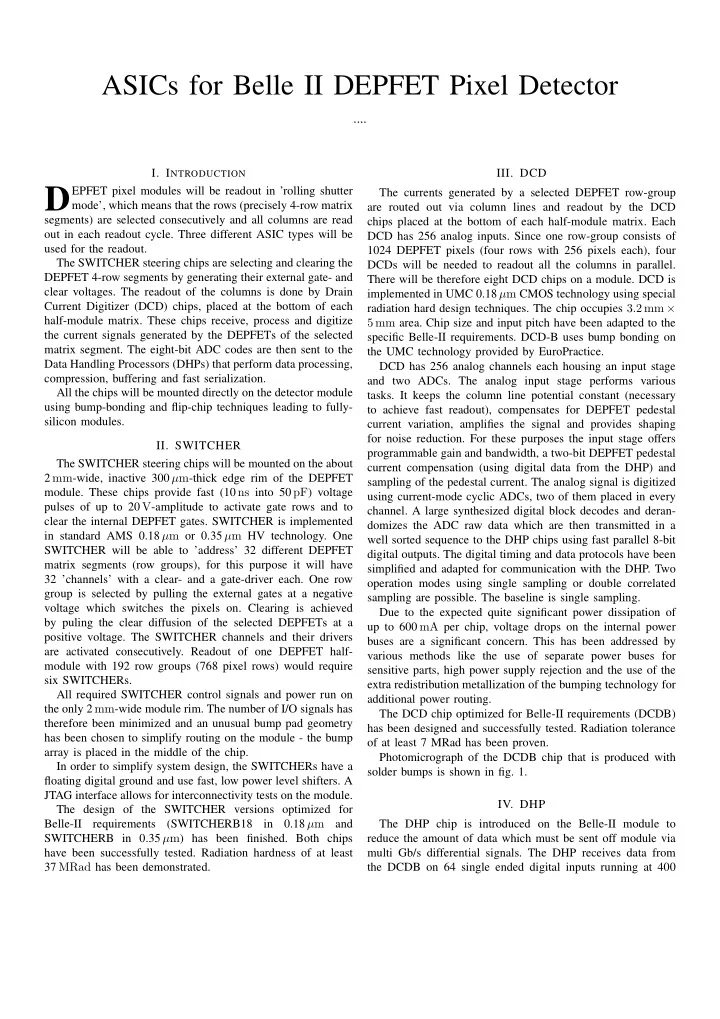

ASICs for Belle II DEPFET Pixel Detector .... I. I NTRODUCTION III. DCD D EPFET pixel modules will be readout in ’rolling shutter The currents generated by a selected DEPFET row-group mode’, which means that the rows (precisely 4-row matrix are routed out via column lines and readout by the DCD segments) are selected consecutively and all columns are read chips placed at the bottom of each half-module matrix. Each out in each readout cycle. Three different ASIC types will be DCD has 256 analog inputs. Since one row-group consists of used for the readout. 1024 DEPFET pixels (four rows with 256 pixels each), four The SWITCHER steering chips are selecting and clearing the DCDs will be needed to readout all the columns in parallel. DEPFET 4-row segments by generating their external gate- and There will be therefore eight DCD chips on a module. DCD is clear voltages. The readout of the columns is done by Drain implemented in UMC 0.18 µ m CMOS technology using special Current Digitizer (DCD) chips, placed at the bottom of each radiation hard design techniques. The chip occupies 3 . 2 mm × half-module matrix. These chips receive, process and digitize 5 mm area. Chip size and input pitch have been adapted to the the current signals generated by the DEPFETs of the selected specific Belle-II requirements. DCD-B uses bump bonding on matrix segment. The eight-bit ADC codes are then sent to the the UMC technology provided by EuroPractice. Data Handling Processors (DHPs) that perform data processing, DCD has 256 analog channels each housing an input stage compression, buffering and fast serialization. and two ADCs. The analog input stage performs various All the chips will be mounted directly on the detector module tasks. It keeps the column line potential constant (necessary using bump-bonding and flip-chip techniques leading to fully- to achieve fast readout), compensates for DEPFET pedestal silicon modules. current variation, amplifies the signal and provides shaping for noise reduction. For these purposes the input stage offers II. SWITCHER programmable gain and bandwidth, a two-bit DEPFET pedestal The SWITCHER steering chips will be mounted on the about current compensation (using digital data from the DHP) and 2 mm -wide, inactive 300 µ m -thick edge rim of the DEPFET sampling of the pedestal current. The analog signal is digitized module. These chips provide fast (10 ns into 50 pF ) voltage using current-mode cyclic ADCs, two of them placed in every pulses of up to 20 V -amplitude to activate gate rows and to channel. A large synthesized digital block decodes and deran- clear the internal DEPFET gates. SWITCHER is implemented domizes the ADC raw data which are then transmitted in a in standard AMS 0.18 µ m or 0.35 µ m HV technology. One well sorted sequence to the DHP chips using fast parallel 8-bit SWITCHER will be able to ’address’ 32 different DEPFET digital outputs. The digital timing and data protocols have been matrix segments (row groups), for this purpose it will have simplified and adapted for communication with the DHP. Two 32 ’channels’ with a clear- and a gate-driver each. One row operation modes using single sampling or double correlated group is selected by pulling the external gates at a negative sampling are possible. The baseline is single sampling. voltage which switches the pixels on. Clearing is achieved Due to the expected quite significant power dissipation of by puling the clear diffusion of the selected DEPFETs at a up to 600 mA per chip, voltage drops on the internal power positive voltage. The SWITCHER channels and their drivers buses are a significant concern. This has been addressed by are activated consecutively. Readout of one DEPFET half- various methods like the use of separate power buses for module with 192 row groups (768 pixel rows) would require sensitive parts, high power supply rejection and the use of the six SWITCHERs. extra redistribution metallization of the bumping technology for All required SWITCHER control signals and power run on additional power routing. the only 2 mm -wide module rim. The number of I/O signals has The DCD chip optimized for Belle-II requirements (DCDB) therefore been minimized and an unusual bump pad geometry has been designed and successfully tested. Radiation tolerance has been chosen to simplify routing on the module - the bump of at least 7 MRad has been proven. array is placed in the middle of the chip. Photomicrograph of the DCDB chip that is produced with In order to simplify system design, the SWITCHERs have a solder bumps is shown in fig. 1. floating digital ground and use fast, low power level shifters. A JTAG interface allows for interconnectivity tests on the module. IV. DHP The design of the SWITCHER versions optimized for 0.18 µ m Belle-II requirements (SWITCHERB18 in and The DHP chip is introduced on the Belle-II module to SWITCHERB in 0.35 µ m ) has been finished. Both chips reduce the amount of data which must be sent off module via have been successfully tested. Radiation hardness of at least multi Gb/s differential signals. The DHP receives data from 37 MRad has been demonstrated. the DCDB on 64 single ended digital inputs running at 400
Recommend
More recommend